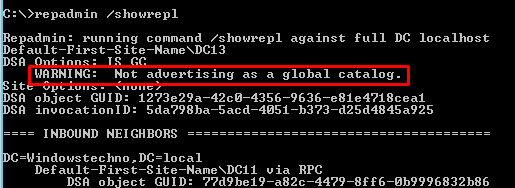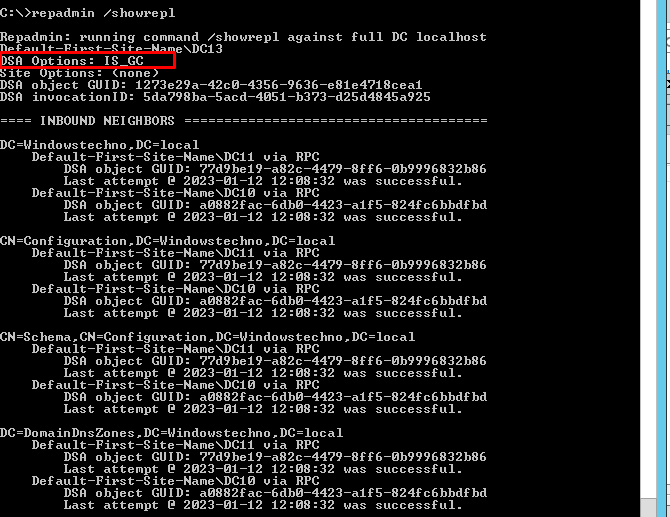WARNING: Not advertising as a global catalog.
Hello All,
Hope this post finds you in good health and spirit.
WARNING: Not advertising as a global catalog.

- Check Directory Service logs.
- Check the possible causes of global catalog promotion failure.
- Check Active directory domain service status.
- Global catalog promotion failure cause.
- Solution to fix the global catalog promotion failure issue.
Symptoms
It’s possible that a domain controller won’t consider itself to be a global catalog server when you attempt to promote it. This is true if you advertise the domain controller through scripting or by clicking the Global Catalog option. Event messages are generated in the Directory Services log when this issue comes up.
Additionally, the output can show that the domain controller is not advertising the global catalog because it failed the advertising test. When a domain controller reports event ID 1578 and you perform a domain controller diagnostic check on that domain controller (Dcdiag.exe), this result is generated.
When you restart the ADDS service but it’s not starting and showing as stopping service. You reboot the domain controller to fix the problem , ADDS stopping service will resolve but you will have encountered with this GC problem – WARNING: Not advertising as a global catalog.
Cause
Before a global catalog may advertise the global catalog role, it must replicate inbound copies of all objects from all domain partitions in the forest.
The KCC on the domain controller that is being promoted creates connection objects from source domain controllers that host the required partitions when that domain controller is selected to host the global catalog. These source domain controllers might be existing global catalog already existing in the forest or domain controllers hosting writable copies of each domain partition located within its forest. Then, from source domain controllers chosen by the KCC, the contents of each domain partition are inbound replicated.
Over existing or newly developed connection links, the contents are replicated to the newly promoted global catalog.
Global catalog promotion may fail if one of the following conditions is true:
- A cross-reference object to an outdated or orphaned domain is available in the configuration partition of one or more domain controllers, but there are no domain controllers for that domain in the forest.
- The configuration partition of one or more domain controllers has metadata for a source domain controller that the KCC specifies, but which does not correspond to a domain controller that is currently active in the forest.
- The KCC’s chosen source domain controller for the global catalog that is being advertised is not available.
- The source domain controller that the KCC chose from the globally advertised catalog cannot be reached via the network. Due to poor or nonexistent network connectivity, this domain controller cannot be accessed.
-
- Ports that are blocked
- IP addresses that are filtered
- Networks that are not fully routed but that have the bridge-all-site-linksoption enabled
- Administrators have wrongly chosen non-global catalogu domain controllers as preferred bridgeheads, preventing source domain global catalog from serving as bridgeheads.
- Due to the problem status that is recorded in one of the events given in the Summary section, the global catalog that is being promoted is unable to create a connection link from the chosen source domain controller..
The domain controller won’t be able to finish the replication if there is an orphaned domain. Until replication is finished, the domain controller cannot promote itself as a global catalog server. A domain that is orphaned might result from a number of problems:
- All of a domain’s domain controllers were removed from Active Directory, but the domain partition cross-reference object remains.
- On a domain controller, both Active Directory and the domain controller’s directory partition were deleted. The domain controller was eventually recreated prior to replication finishing. These occurrences resulted in persistent phantoms that an erroneously referenced cross-reference object.
- The domain controller having the issue has not received the domain-naming update for the domain. Or, it’s possible that no domain controllers outside of the newly elevated domain received the domain-naming change for that domain. This difficulty would only last a short while.
Resolution
To resolve this problem, first identify the root cause of the replication issue, and resolve that problem. Determine whether the replication issue is caused by one of the following conditions:
- A replication delay
- An orphaned domain that is located in the forest environment
- An inability to build the connection link
- An inability to replicate over the connection agreement
- Restart the DC and wait for some time to adverting DC as GC

Use that event viewer to check the cause of the replication failure for the same domain partition if an NTDS KCC event ID 1265 is logged in the Directory Service log.
Ensure that there are no blocked network ports and that network connectivity is strong. TCP 135 and the ephemeral ports used by RPC are two examples of network ports that must be used. To confirm that the registered Host and SRV entries are all appropriately registered, check the DNS records. You must delete any inaccurate records and register any new ones if there are any.
Remove all stale metadata for any domain controllers and domains in the forest that are listed in the relevant event IDs.
Also check this
Disabling and Enabling Outbound Replication
So, that’s all in this blog. I will meet you soon with next stuff .Have a nice day !!!
Recommended content
How to Check the Active Directory Database Integrity
Disabling and Enabling the Outbound Replication
DFS Replication Service Stopped Replication
What is Strict Replication Consistency
The replication operation failed because of a schema mismatch between the servers involved
Troubleshooting ad replication error 8418 the replication operation failed because of a schema mismatch between the servers
How to export replication information in txt file
Repadmin Replsummary
Enabling the outbound replication
Disabling and enabling replication on schema master domain controller
How to enable strict replication consistency
How to prevent lingering objects replication in active directory
AD replication process overview
How to force active directory replication
Change notification in replication process
How to check replication partner for a specific domain controller
dcdiag test replications
Guys please don’t forget to like and share the post.Also join our WindowsTechno Community and where you can post your queries/doubts and our experts will address them .
You can also share the feedback on below windows techno email id.
If you have any questions feel free to contact us on admin@windowstechno.com also follow us on facebook@windowstechno to get updates about new blog posts.
